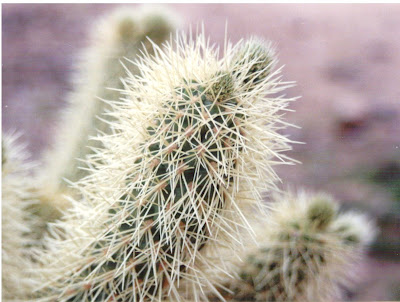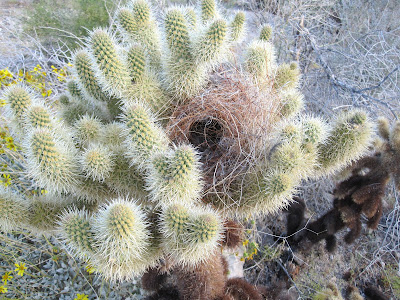The teddy bear cholla (Cylindropuntia bigelovii) is found in southeastern California, Arizona and northwestern Mexico at elevations of 100 to 3,600 feet. The one below was in Organ Pipe Cactus National Monument in southern Arizona.
It has light green to blue-green stems, that from a distance, look soft and fuzzy, like the fur of a teddy bear.
Close-up, the soft and fuzzy appearance gives way to one of the most impressive suits of armor in the natural world: a dense forest of silvery-white spines that completely cover the stem.
The spines are about an inch long and have a detachable, paper-like, sheath.
The thick coat of spines provides protection from sunlight as well as from animals that would otherwise eat it. The teddy bear cholla stands erect, with one trunk, getting as tall as seven feet, and has horizontal branches. The lower branches tend to fall off and the trunk darkens with age as the spines turn dark chocolate brown to black. I don't have any real good pictures of the darker spines, as I've tended to view the older plants as kind of ugly. This picture of Andrew below was taken near Corn Springs, and as evidenced by the size and color, is an old cholla.
It has yellow-green flowers
that form at the tips of its stems
in May and June.
The teddy bear chollas below, in Organ Pipe, have quite a few buds.
A closer view of the buds.
An even closer view of the buds.
A bud that has flowered. The flowers are quite exotic, with lime green, yellow, white and rose accents on the outer portion of the inner leaves.
A flower next to two buds in various stages.
The fruit that follow rarely have viable seed. The teddy bear cholla reproduces from dropped stems, like the chain fruit cholla, and similarly, the ground around them is often littered with cactus segments. For that reason, like with the chain fruit cholla, teddy bear chollas can form "forests" as dropped segments reproduce additional chollas. The teddy bear cholla is probably the most common cholla I see in my desert visits and they can be quite beautiful and striking in their own way when you stumble into a "forest" of them. I believe the largest forest I've seen is off the Hayfield Road exit of the I-10 on the bajada south of the Eagle Mountains. The cholla are thick, the area is large and you have to step very carefully in order to avoid stepping on or brushing against spines.
The cholla forest below is in Joshua Tree National Park. Rachael, Mom Kenison (who loved cactus), Andrew, Sam and me.
The cholla forest below is in Joshua Tree National Park. Rachael, Mom Kenison (who loved cactus), Andrew, Sam and me.
These teddy bears are in Grass Canyon in Organ Pipe.
These older cholla are on the Chuckwalla Bench.
A much newer colony outside Alamo Canyon in Organ Pipe.
Passing animals get snared by cactus segments which helps to disperse them to other areas, to take root and grow additional plants. Passing animals can include humans. Sam, with a cholla segment attached to his ankle in Grass Canyon.
Pack rats use the spines as a defense around their burrows. The picture below is of a mine we found on the Chuckwalla Bench. About 20 yards in we found a layer of cholla spines about three feet deep and 20 yards long. It was the most formidable barrier to a burrow I've ever seen.
The boys I was with, on a camping trip with Jim Sullivan and the Boy Scouts, had tennis shoes that were pierced by the spines and we had to retreat. Birds, like cactus wrens, also build nests among their spines.





















I've learned a lot about cactus by reading your blog. About the only experience I have had with these plants is the year we mothers all received cacti for our Mother's Day gift in church. The SS President (who's orchestrated the gfit) took a lot of heat for that, but the next year he justified his decision by saying that many still had their cactus plants, and how often could you say that one year later? We received candy bars that year.
ReplyDeletemleh
ReplyDelete